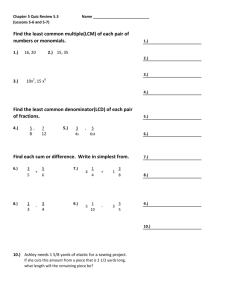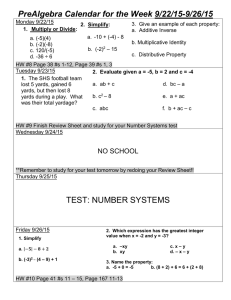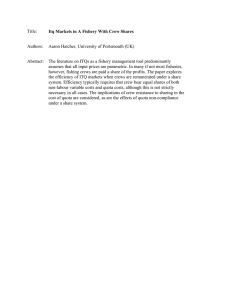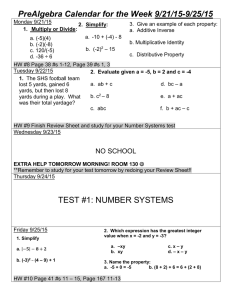Competitiveness, Strategy, Productivity Homework with Solution
advertisement
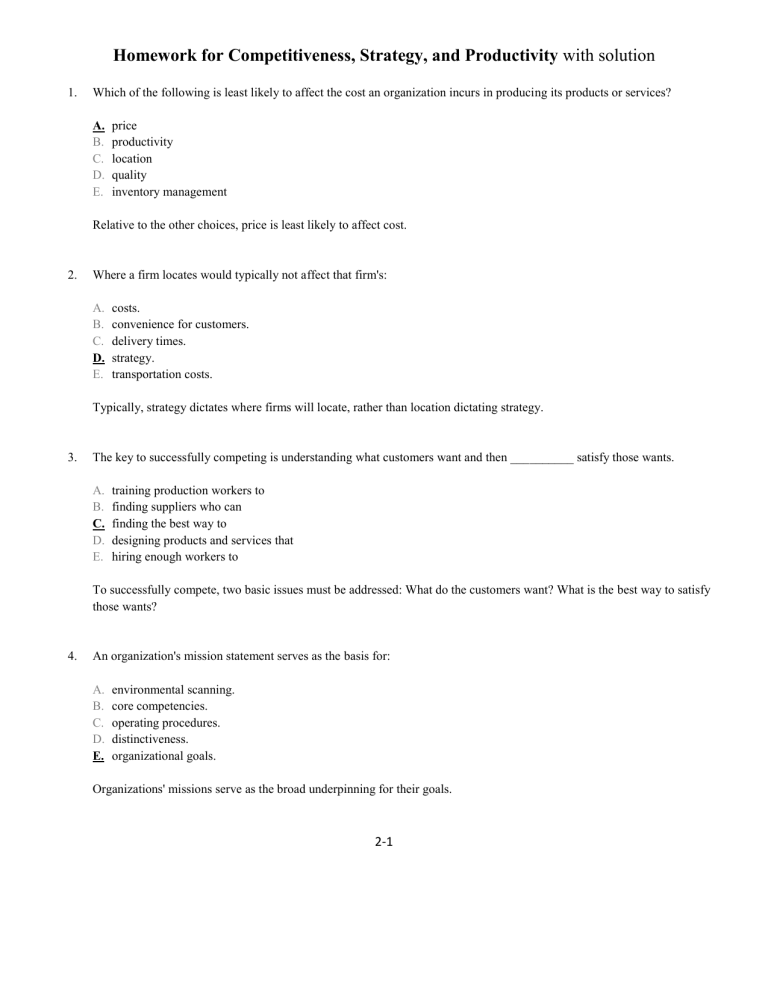
Homework for Competitiveness, Strategy, and Productivity with solution 1. Which of the following is least likely to affect the cost an organization incurs in producing its products or services? A. B. C. D. E. price productivity location quality inventory management Relative to the other choices, price is least likely to affect cost. 2. Where a firm locates would typically not affect that firm's: A. B. C. D. E. costs. convenience for customers. delivery times. strategy. transportation costs. Typically, strategy dictates where firms will locate, rather than location dictating strategy. 3. The key to successfully competing is understanding what customers want and then __________ satisfy those wants. A. B. C. D. E. training production workers to finding suppliers who can finding the best way to designing products and services that hiring enough workers to To successfully compete, two basic issues must be addressed: What do the customers want? What is the best way to satisfy those wants? 4. An organization's mission statement serves as the basis for: A. B. C. D. E. environmental scanning. core competencies. operating procedures. distinctiveness. organizational goals. Organizations' missions serve as the broad underpinning for their goals. 2-1 5. Which of the following would be least important in the pursuit of a time-based strategy? A. B. C. D. E. cost minimization quick changeover times operational agility reduced complaint resolution times flexible technology Many means for minimizing cost would have the effect of making a time-based strategy less feasible. 6. Competitiveness doesn't include: A. B. C. D. E. productivity. effectiveness. profitability. operations strategy. operations management. A company can be competitive relative to similar companies and still be unprofitable if the competitive environment is inherently unprofitable. 7. Product design and choice of location are examples of _______ decisions. A. B. C. D. E. strategic tactical operational customer-focused design These decisions are made high in the hierarchy. 8. Scheduling personnel is an example of an operations management: A. B. C. D. E. mission implementation. operational decision. organizational strategy. functional strategy. tactical decision. Scheduling decisions are made low in the hierarchy. 2-2 9. Productivity is expressed as: A. B. C. D. E. output plus input. output minus input. output times input. output divided by input. input divided by output. Productivity is the ratio of outputs to inputs. 10. The manager of a carpet store is trying to determine the best installation crew size. He has tried various crew sizes with the results shown below. Based on productivity, what crew size do you recommend? Crew Size 2 4 3 3 4 2 Yards Installed 716 1298 1017 1002 1278 702 A. 2 B. 3 C. 4 Crews of two workers are most productive with an average of ((716 + 702) / 2 ) / 2) = 354.5 yards/worker installed. The average productivity of three-worker crews is 336.5 yards/worker and for four-worker crews it is 322 yards/worker. 2-3 11. The weekly output of a fabrication process is shown below, together with data for labor and material inputs. Standard selling price is $125 per unit. Overhead is charged weekly at the rate of $1,500 plus .5 times direct labor cost. Assume a 40-hour week and an hourly wage of $16. Material cost is $10 per foot. What is the average multifactor productivity? Week 1 2 Output 392 408 #Workers 5 6 Material (ft) 2720 2790 A. 1.463 B. 1.457 C. 1.431 Calculate multifactor productivity for each week, then average the two. Week 1: (392*$125)/((5 × 40 × $16) + ($1,500 + 0.5 × (5 × 40 × $16)) + (2720 × $10)) = 1.4627 Week 2: (408*$125)/((6 × 40 × $16) + ($1,500 + 0.5 × (6 × 40 × $16)) + (2790 × $10)) = 1.4505 Average = (1.4627 + 1.4505) / 2 = 1.4566 or 1.457 12. A firm pursuing a strategy based on customization and variety will tend to structure and manage its supply chain to accommodate more _____________ than a firm pursuing a strategy based on low cost and high volume. A. B. C. D. E. variation streamlined flow quality capacity productivity Customization and variety lead to variation that must be accommodated. 13. Unique attributes of firms that give them a competitive edge are called: A. B. C. D. E. functional strategies. Balanced Scorecards. supply chains. core competencies. sustainable initiatives. Core competencies can be translated into competitive advantage. 2-4 14. Years ago in the overnight delivery business, providing package tracking capability gave some firms a competitive advantage. Now, all firms must offer this capability simply to be in this line of business. This is an example of ______________ becoming ____________ over time. A. B. C. D. E. tactical implications; strategic strategic implications; tactical order winners; order qualifiers profitability factors; productivity factors order qualifiers; order winners What is an order qualifier and what is an order winner changes over time. 15. ___________ is generally used to facilitate an organization strategy that emphasizes low cost. A. B. C. D. E. Speed to market Flexibility Customization Sustainability Standardization Standardization is a powerful means of achieving low-cost production. 16. Which of the following factors would tend to reduce productivity? A. B. C. D. E. improvements in workplace safety reductions in labor turnover more inexperienced workers reductions in the scrap rate less variety in the product mix More inexperienced workers tend to be less productive. 2-5

